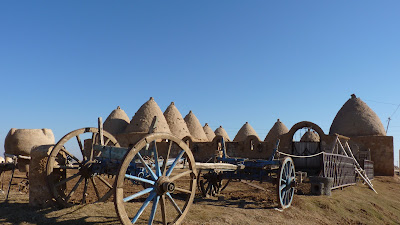While in Urfa, we hired the owner of our guesthouse to take us on an all-day tour of the surrounding countryside. It was an excellent tour, and we saw seven different sights, all of them worthwhile, some of them associated with grand biblical events.
Our first stop was a cave just outside the city, where according to legend, Job took refuge for seven years after becoming ill and losing all of his worldly possessions. The cave attracts pilgrims who come to pray in a mosque on the site and to drink the same healing well water that saved Job. The highlight of our visit was the exquisite interior of the mosque, which matched anything we saw in Istanbul.
Our second stop was Harran, an atmospheric village near the Syrian border where the first language is Arabic (not Turkish or Kurdish). Harran is one of the world's oldest continuously inhabited places and has three principal attractions: traditional beehive-shaped homes made of mud, which are based on a 3,000 year-old design intended to keep residents cool in the searing summer heat; a crumbling 11th century fortress; and the ruins of ancient Harran, which include the world's first Islamic university, built in the 8th century, and destroyed by the Mongols some 500 years later.
 |
| Traditional Harran home, ready to accommodate tourists |
 |
| The crumbling Harran fortress |
 |
| Talia enjoying the rocky ruins of ancient Harran |
 |
| Jeremy too |
 |
| Keeping Harran clean |
 |
| I wouldn't mess with her |
 |
| A mosque in Harran |
 |
| Making bread (it's simple, but very tasty) |
 |
| Drying wool |
Our third stop was the Bazda caves, an ancient rock quarry that was used to build Harran. As we approached the cave, a crowd of small children gathered to join us. We bought a big bag of candy at a nearby shop, and Talia was kind enough to hand out the goodies to our little band of followers.
 |
| Talia hands out the candy |
 |
| Local passersby |
Our fifth stop was the Han el Barur Caravanserai, a travelers' inn built nearly 900 years ago to serve trade caravans. It looks like it hasn't been restored in centuries, and apart from a few curious locals, the only other visitors were some wild turkeys.
Our fifth stop was Suayb City, a small village with ancient ruins and caves where Jethro, Moses' father-in-law, reportedly lived for awhile. The living village sits right atop and around the ancient ruins, making for a fascinating juxtaposition. The locals were very friendly and one family even posed for pictures!
 |
| I wonder what sports channels are part of their satellite TV package? |
 |
| One of the many ancient caves found in Suayb City |
Our sixth stop was Sogmatar, another small village set atop ancient caves and ruins. There's an open-air pagan temple with a commanding hilltop view, a cave with statues and Assyrian inscriptions carved into the walls, and a welcoming village with a lively schoolhouse. It's all set in an eerily beautiful landscape of barren rock ledges and vast open spaces. The kids loved climbing and scampering on the rocks, and it was definitely our favorite sight of the day.
 |
| Ancient cave couple |
 |
| Must be time for recess |
 |
| Anyone read ancient Assyrian (or whatever language this is)? Some of it looks like Hebrew. |
 |
| A shepherd guides her flock |
Our final stop was Gobelki Tepe, the oldest known human-made place of worship on earth. It dates back to the 10th millennium BCE - about 11,500 years ago! Before excavations began, a temple complex of this scale was not thought possible by a community so ancient. Most of the site is under intensive excavation, although one can see a couple of impressive reliefs. It's amazing to think that this place actually predates Jericho (in the West Bank in Israel) by about 1,000 years. The views from the hilltop temple add to the aura of the site.
All that in one day - and the best thing was that a delicious hot dinner was waiting for us when we got back to our guesthouse in Urfa. Next stop: Diyarbakir.













































No comments:
Post a Comment